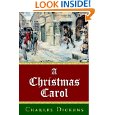A CHRISTMAS CAROL, by Charles Dickens Dickens is probably the best known and loved author of the Victorian era. He wrote many memorable tales.
A Christmas Carol may be the most popular one. At the age of 12, some sources say that Charles Dickens worked for 12 hours a day, six days a week in a boot factory finishing the bottles of boot polish. On the seventh day he visited his family at the Marshalsea debtors’ prison. This lasted for two years (a traumatic time for young Dickens). He never forgot it, yet, he used his pain to create memorable characters like Scrooge and Tiny Tim, Bob Cratchit’s disabled little boy.
The reader can almost see young Dickens chained by poverty to his polish pots as little Tiny Tim is invisibly linked to his crutch. The descriptions and dialogues are rich. The characters are striking and memorable. The imagery is colourful, despite the bleakness of the winter months.
The story told in this book is to apply to most of us. Even in our old age it is not too late to change. In Dickens’ tale Ebenezer Scrooge, an old miser, bitter and resentful man is shown his past, his present, and his future by three ghosts. The first ghost reminds him of how he once enjoyed life’s pleasures. The second ghost shows Scrooge his current deplorable state. The final ghost foretells the likely outcome of his way.
This book it is not so much a Christmas story as a New Year’s story. For those of us who want to change the course of our life, for those of us who want this year’s resolutions to actually mean something, we need to go through an Ebenezer-like process. Whether your life is a bad life or an abused life or a flat life, you can use the ideas from this simple story.
Alberto R. Ayala


 Tradition:
Tradition: